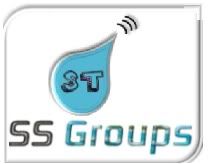
The most common English-language key pattern for typewriters and keyboards is called QWERTY, after the layout of the first six letters in the top row of its keys (from left to right).
In the late 1860s, American inventor and printer Christopher Sholes invented the modern form of the typewriter. Sholes created the QWERTY keyboard layout by separating commonly used letters so that typists would type slower and not jam their mechanical typewriters. Subsequent generations of typists have learned to type using QWERTY keyboards, prompting manufacturers to maintain this key orientation on typewriters.

Computer keyboards copied the QWERTY key layout and have followed the precedent set by typewriter manufacturers of keeping this convention. Modern keyboards connect with the computer CPU by cable or by infrared transmitter. When a key on the keyboard is pressed, a numeric code is sent to the keyboard’s driver software and to the computer’s operating system software. The driver translates this data into a specialized command that the computer’s CPU and application programs understand. In this way, users may enter text, commands, numbers, or other data. The term character is generally reserved for letters, numbers, and punctuation, but may also include control codes, graphical symbols, mathematical symbols, and graphic images.
 Almost all standard English-language keyboards have keys for each character of the American Standard Code for Information Interchange (ASCII) character set, as well as various function keys. Most computers and applications today use seven or eight data bits for each character. Other character sets include ISO Latin 1, Kanji, and Unicode. Each character is represented by a unique number understood by the computer. For example, ASCII code 65 is equal to the letter A. The function keys generate short, fixed sequences of character codes that instruct application programs running on the computer to perform certain actions. Often, keyboards also have directional buttons for moving the screen cursor, separate numeric pads for entering numeric and arithmetic data, and a switch for turning the computer on and off. Some keyboards, including most for laptop computers, also incorporate a trackball, mouse pad, or other cursor-directing device. No standard exists for positioning the function, numeric, and other buttons on a keyboard relative to the QWERTY and other typewriting keys. Thus layouts vary on keyboards.
Almost all standard English-language keyboards have keys for each character of the American Standard Code for Information Interchange (ASCII) character set, as well as various function keys. Most computers and applications today use seven or eight data bits for each character. Other character sets include ISO Latin 1, Kanji, and Unicode. Each character is represented by a unique number understood by the computer. For example, ASCII code 65 is equal to the letter A. The function keys generate short, fixed sequences of character codes that instruct application programs running on the computer to perform certain actions. Often, keyboards also have directional buttons for moving the screen cursor, separate numeric pads for entering numeric and arithmetic data, and a switch for turning the computer on and off. Some keyboards, including most for laptop computers, also incorporate a trackball, mouse pad, or other cursor-directing device. No standard exists for positioning the function, numeric, and other buttons on a keyboard relative to the QWERTY and other typewriting keys. Thus layouts vary on keyboards. An alternative keyboard design not yet widely used but broadly acknowledged for its speed advantages is the Dvorak keyboard. In the 1930s, American educators August Dvorak and William Dealy designed this key set so that the letters that make up most words in the English language are in the middle row of keys and are easily reachable by a typist’s fingers. Common letter combinations are also positioned so that they can be typed quickly. Most keyboards are arranged in rectangles, left to right around the QWERTY layout. Newer, innovative keyboard designs are more ergonomic in shape. These keyboards have separated banks of keys and are less likely to cause carpal tunnel syndrome, a disorder often caused by excessive typing on less ergonomic keyboards.
An alternative keyboard design not yet widely used but broadly acknowledged for its speed advantages is the Dvorak keyboard. In the 1930s, American educators August Dvorak and William Dealy designed this key set so that the letters that make up most words in the English language are in the middle row of keys and are easily reachable by a typist’s fingers. Common letter combinations are also positioned so that they can be typed quickly. Most keyboards are arranged in rectangles, left to right around the QWERTY layout. Newer, innovative keyboard designs are more ergonomic in shape. These keyboards have separated banks of keys and are less likely to cause carpal tunnel syndrome, a disorder often caused by excessive typing on less ergonomic keyboards.
















